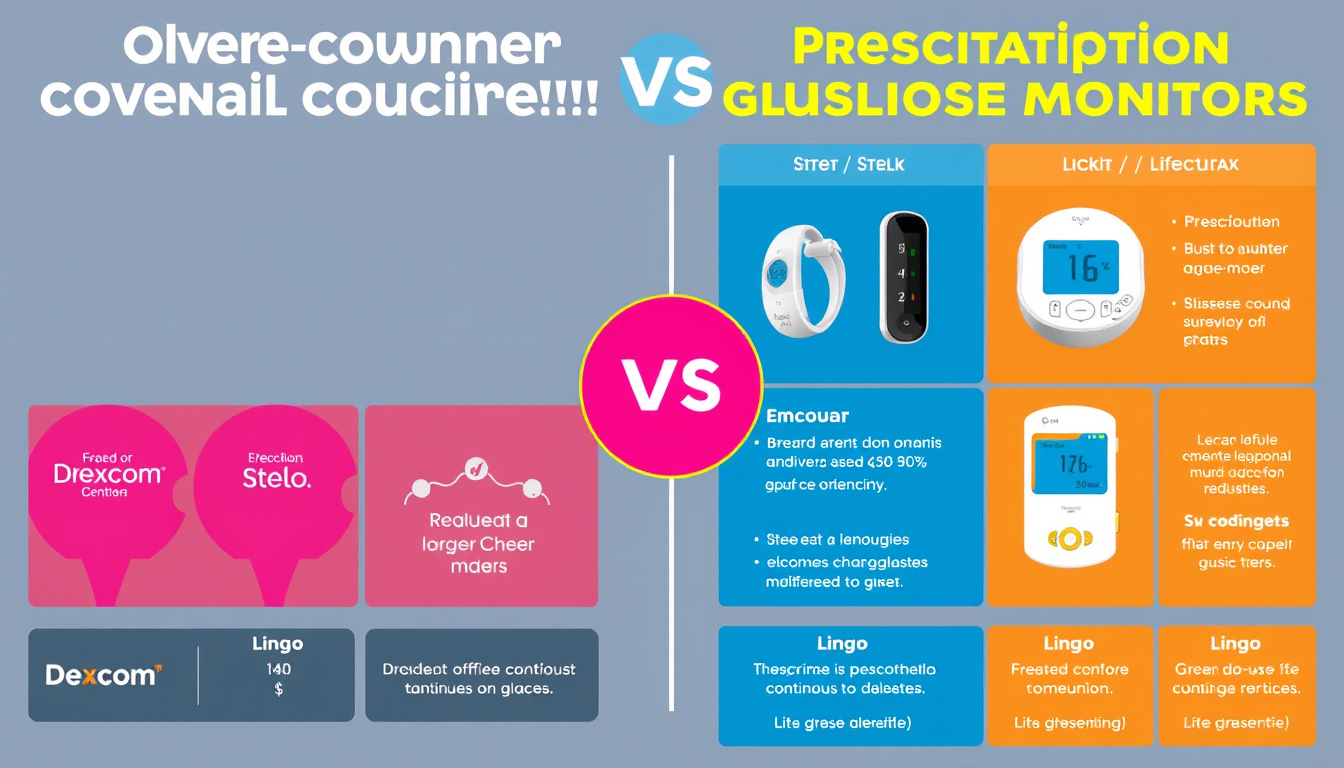Comparing Over-the-Counter and Prescription Continuous Glucose Monitors: A Deep Dive into Dexcom, Stelo, Libre, and Lingo
 Jill Smith
Jill Smith
Continuous glucose monitors (CGMs) have revolutionized diabetes management by providing real-time blood sugar readings without the need for frequent finger sticks. With several CGMs available, both prescription-based and over-the-counter (OTC), choosing the right device can be challenging. In this article, we explore four popular CGM options—Dexcom, Stelo, Libre, and Lingo—highlighting their accuracy, practicality, and overall user experience based on hands-on testing.
Overview of Devices Tested
- Dexcom: A widely used prescription CGM known for accuracy and reliable performance.
- Stelo: An OTC CGM designed as the Dexcom counterpart, available without the need for a prescription.
- Libre 3 Plus & Lingo: The Libre 3 Plus is a leading prescription CGM, while Lingo serves as its OTC alternative.
Application and Wear Experience
Applying CGMs varies slightly among devices. The Dexcom sensor features a small needle and an activation button, allowing simple insertion into the skin with minimal discomfort—though one tester did encounter light bleeding possibly from a small vein. The Stelo device looks very similar to Dexcom and functions comparably, also being fairly painless during insertion.
The Libre sensors, including its OTC variant Lingo, have a different application technique involving aligning and pressing components before attaching to the arm. Lingo, however, was found to be bulkier and reportedly failed after just three days of use, which impacts reliability concerns for OTC CGMs. In contrast, Dexcom and Stelo demonstrated stability over multiple days.
Size and Design Differences
One notable difference was in size: Lingo appeared much larger than the others, which may affect user comfort and discretion. Stelo essentially matches Dexcom in compactness and design, offering a more appealing form factor for OTC options.
Activation & Calibration Time
CGMs typically require a waiting period (30 minutes to an hour) before sensor activation, which remained consistent across devices. Apps for data monitoring were downloaded and used to track readings.
Accuracy Comparison
The true test of CGMs lies in their accuracy during blood sugar fluctuations:
- After consuming muffins intended to spike blood sugar, readings were taken simultaneously from all four CGMs plus a traditional finger stick monitor.
- Stelo reported 120 mg/dL, Dexcom showed 125 mg/dL, Libre read 119 mg/dL, and finger stick measurement was 117 mg/dL.
All devices demonstrated close agreement with each other and with the finger stick values, debunking some claims that CGMs are inherently inaccurate during rapid blood sugar changes.
Considerations at Low Blood Sugar Ranges
Some users note that CGMs, including Dexcom and Libre (and their OTC counterparts), occasionally show blood sugar readings lower than actual when glucose levels drop. This safety feature aims to alert users to potentially dangerous lows by erring on the side of caution, which can sometimes lead to confusion if symptoms don’t match sensor readings.
Reliability and Longevity
- Dexcom and Stelo sensors maintained functionality beyond four or five days.
- Lingo and Libre OTC sensors reportedly failed earlier, with Lingo dying the day after application and Libre OTC stopping after three days.
Reliability is critical for continuous glucose monitoring, making the longer-lasting devices more desirable.
Final Verdict: Which CGM Stands Out?
- Prescription Devices: Dexcom and Libre 3 Plus both showed excellent accuracy and reliability, with Dexcom slightly edging out for comfort and user experience.
- Over-the-Counter Devices: Between Stelo and Lingo, Stelo proved to be the better choice. It matched Dexcom’s compact design, maintained sensor life longer, and provided more consistent readings.
Conclusion
For individuals seeking continuous glucose monitoring without navigating prescriptions, Stelo represents a strong OTC candidate, combining accuracy and reliability close to prescription devices like Dexcom. While Libre’s OTC offering, Lingo, showed notable shortcomings in size and sensor longevity, overall CGM technology continues to evolve, offering more choices tailored to users' needs.
Understanding your blood sugar trends with accurate and dependable CGMs can greatly improve diabetes management. Whether opting for prescription or OTC devices, consider factors like sensor lifespan, ease of use, and real-time accuracy when making your choice.
Turn Back the Clock: Unlock the Secrets to Reverse Diabetes in 30 Days. Don't Wait! Download Now
Subscribe to my newsletter
Read articles from Jill Smith directly inside your inbox. Subscribe to the newsletter, and don't miss out.
Written by
